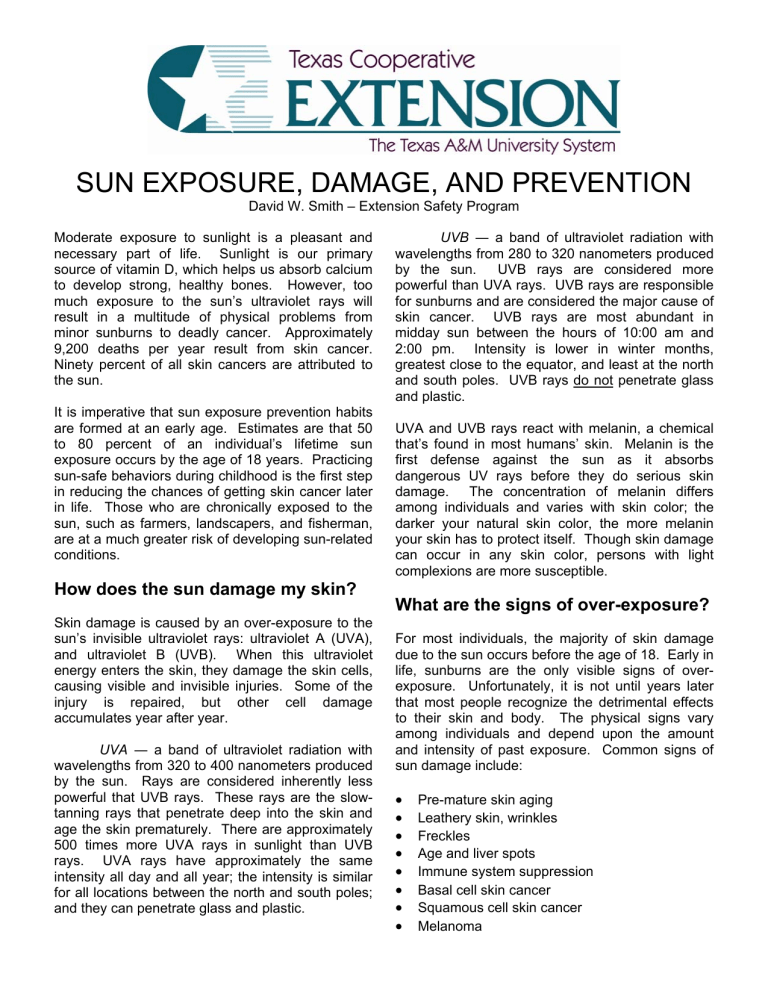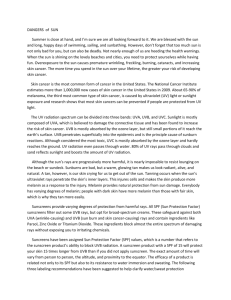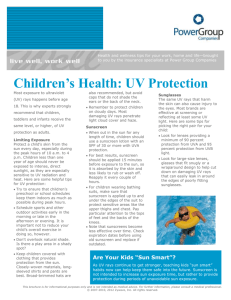SUN EXPOSURE, DAMAGE, AND PREVENTION

SUN EXPOSURE, DAMAGE, AND PREVENTION
David W. Smith – Extension Safety Program
Moderate exposure to sunlight is a pleasant and necessary part of life. Sunlight is our primary source of vitamin D, which helps us absorb calcium to develop strong, healthy bones. However, too much exposure to the sun’s ultraviolet rays will result in a multitude of physical problems from minor sunburns to deadly cancer. Approximately
9,200 deaths per year result from skin cancer.
Ninety percent of all skin cancers are attributed to the sun.
It is imperative that sun exposure prevention habits are formed at an early age. Estimates are that 50 to 80 percent of an individual’s lifetime sun exposure occurs by the age of 18 years. Practicing sun-safe behaviors during childhood is the first step in reducing the chances of getting skin cancer later in life. Those who are chronically exposed to the sun, such as farmers, landscapers, and fisherman, are at a much greater risk of developing sun-related conditions.
UVB ― a band of ultraviolet radiation with wavelengths from 280 to 320 nanometers produced by the sun. UVB rays are considered more powerful than UVA rays. UVB rays are responsible for sunburns and are considered the major cause of skin cancer. UVB rays are most abundant in midday sun between the hours of 10:00 am and
2:00 pm. Intensity is lower in winter months, greatest close to the equator, and least at the north and south poles. UVB rays do not penetrate glass and plastic.
UVA and UVB rays react with melanin, a chemical that’s found in most humans’ skin. Melanin is the first defense against the sun as it absorbs dangerous UV rays before they do serious skin damage. The concentration of melanin differs among individuals and varies with skin color; the darker your natural skin color, the more melanin your skin has to protect itself. Though skin damage can occur in any skin color, persons with light complexions are more susceptible.
How does the sun damage my skin?
Skin damage is caused by an over-exposure to the sun’s invisible ultraviolet rays: ultraviolet A (UVA), and ultraviolet B (UVB). When this ultraviolet energy enters the skin, they damage the skin cells, causing visible and invisible injuries. Some of the injury is repaired, but other cell damage accumulates year after year.
UVA ― a band of ultraviolet radiation with wavelengths from 320 to 400 nanometers produced by the sun. Rays are considered inherently less powerful that UVB rays. These rays are the slowtanning rays that penetrate deep into the skin and age the skin prematurely. There are approximately
500 times more UVA rays in sunlight than UVB rays. UVA rays have approximately the same intensity all day and all year; the intensity is similar for all locations between the north and south poles; and they can penetrate glass and plastic.
What are the signs of over-exposure?
For most individuals, the majority of skin damage due to the sun occurs before the age of 18. Early in life, sunburns are the only visible signs of overexposure. Unfortunately, it is not until years later that most people recognize the detrimental effects to their skin and body. The physical signs vary among individuals and depend upon the amount and intensity of past exposure. Common signs of sun damage include:
• Pre-mature skin aging
• Leathery skin, wrinkles
• Freckles
• Age and liver spots
• Immune system suppression
•
•
Basal cell skin cancer
Squamous ce ll skin cancer
• Melanoma
Skin cancer is the most common form of cancer in the United States with more than one million cases reported annually. Skin cancers are classifie d as e ither malignant melanoma or non-melanoma.
• Non-melanoma cancer includes basal cell carcinoma and squamous cell carcinoma.
¾ Basal cell carcinoma is the most common form of skin cancer. Spreading to other parts is very unlikely. It is best treated when detected ea rly and can be cured with proper treatment.
¾ Squamous cell carcinoma is the second most common form of skin cancer.
Spreading to other parts of the body is very unusual. It is best treated when detected early and can be cured wi th proper treatment.
• Malignant melanoma is a life-threatening form of
“black mole” skin cancer. Early treatment can be curative. There is a high likelihood of spreading to other parts of the body if it is not detected and treated early. If treatment is delayed, it often causes death.
H ow can I prevent sun damage?
Avoid direct sun exposure
, especially between the hours of 10:00 am and 2:00 pm. Midday summer sunlight has the greatest concentration and intensity of UVA and UVB rays. As a general rule, if your shadow is as long as you are tall, then ther e is less ri sk from the damaging effects of UV rays.
Avoid artificial tanning devices as much as possible.
The UV radiation emitted by indoor tanning lamps is much more intense that natural sunlight. Keep in mind that a tan i s the body’s response to the sun’s d amaging rays.
Wear sunscreen. Select sunscreen with at least a
“sun protection factor” (SPF) rating of 15. If you have a light complexion and are prone to sunburns, sunscreen products with higher SPF ratings are available. (Se e “ How do I select the right sunscreen?
” )
Check your local UV Index . The UV Index is a prediction of the sun’s UV ray strength on any given day in a particular geographic region. The local d aily UV Index is commonly reported in the newspaper, on television, or radio stations.
Wear a hat . Choose a broad-brimmed hat with at least a 3- to 4-inch brim that covers your neck, ears, scalp, and face s
. Baseball caps and visors tend to hade the face but leave the neck, lower face, and ears exposed.
Wear UV-blocking sunglasses . Choose sunglasses with wraparound or large frames to protect your eyelids and the sensitive skin around your eyes.
These are common areas of skin cancer and the most recog
S nizable areas of sun-induced aging. unglasses also help reduce the risk of cataracts later in life.
Wear sun-protective clothing . Tightly woven fabrics and dark colored clothing offer more protection.
Loosely woven, translucent fabrics allow har mful
U V rays to penetrate and damage the skin, even thought the effects are not immediately visible.
Don’t rely upon temperature as an indication of sun
UV intensity . Sun protection should be practiced year round, in all seasons, and even on cloudy days. Though clouds keep much of the sun’s heat from reaching the earth, they only block about 20 percent of harmful UV radiation. Even in winter when temperatures are cooler, reflective surfaces such as water, sand, concrete, and snow can intensify the effect of UV rays and cause skin damage from over-exposure. Snow skiers are at particular r isk considering that ultraviolet radiation in creases 4 to 5 percent with every 1000 feet above sea level.
Protect children and teach them sun safety at an early age . Sun damage occurs with each unprotected exposure and accumulates over the course of a lifetime. Provide children a shady, cool place to play, especially between the hours of 10:00 am and 4:00 pm. Special attention should be given to children who ha b ve fair skin, blonde, red or lightrown hair, blue, green or gray eyes, and numerous moles.
Infants should never be exposed to intense sunlig
S ht . unscreens may irritate a baby’s skin and direct sunlight may damage a baby’s develop ing eyes.
What is “photosensitivity”?
Photosensitivity is any abnormal reaction to sun exposure. While it is common for people with light
2
complexions to develop sunburns when over exposed, certain individuals react abnormally to sunlight. For example, instead of sunburns, people with photosensitivity may develop skin rashes.
Photosensitivity may also result from medical p roblems, diseases, or from a number of medications.
Some medications, including commonly used acne medications and antibiotics, can make skin more susceptible to sun damage. Other medications may cause photosensitive reactions such as rashes, redness, and swelling. In some cases, an allergic reaction of sunscreen ingredients may occur, causing burning and stinging of the skin. If allergic re actions occur, try a different product and consult your physician.
How do I select the right sunscreen?
Sunscreen products are available in lotion, gel, spray, cream, and stick forms. Some sunscreens are water-resistant, sweat-proof, fragrance-free, hypoallergenic, or made especially for sensitive skin. Selecting the right sunscreen product requires that you recognize the level of protection you need, u nderstand what “sun protection factor” (SPF) means, and apply sunscreens properly.
Practically everyone is susceptible to sun damage; however, some individuals are inherently more at risk based upon their skin color. Individuals with light complexions for example tend to burn more rapidly that those with dark complexions. Level of protection also changes depending on length of exposure (how long you will be in the sun), sun intensity (time of day), position relative to reflective surfaces (i.e., working on a white concrete surface), and activity (such as swimming or snow skiing).
Basically, the length and intensity of exposure combin ed with your body’s inherent risk of sun d amage will determine the level of protection you need.
“Sun protection factor” (SPF) refers to a sunscreen's ability to block harmful UVB rays. It does not relate to the ability of a product to block
UVA rays. For example, with a SPF 5 rated sunscreen, you can theoretically stay outside in the sunlight five times longer before getting a sunburn compared to the time required to get a sunburn without using the sunscreen. The higher the SPF n umber, the longer you are protected against sunburn damage.
The actual length of protection will vary for each individual, given the same SPF rating. For example, if “John” tends to burn in 10 minutes of sun exposure and applies a sunscreen with a SPF of 15, then the sunscreen will provide up to 150 minutes of sun protection. However, if “Jane” u sually burns in 20 minutes and applies the same
SPF 15 product, Jane is protected for 300 minutes.
Sun protection factors have also been determined for other types of protection, such as hats and clothing. For example, small-brim hats (less than 1 inch) provide a SPF 1.5 for the nose and minimal protection for the chin. Broad-rim hats (greater than
3 inches) provide a SPF 3 for the cheek, SPF 7 for the nose, SPF 5 for the neck, and SPF 2 for the chin. Typical summer T-shirts only offe r SPF 6.5.
S everal clothing lines specifically designed for sun protection offer up to SPF 30 protection.
Proper application of sunscreen products such as lotions and creams is important to ensure adequate protection. Generally, individuals apply only 20 to
50 percent of the prescribed amount of a sunscreen product that was used to determine the SPF of the product. Consequently, when you use a SPF sunscreen, you may only be getting the sun protection of a SPF 7 or SPF 15 product. Read the in structions carefully and apply the recommended amount for proper coverage.
Preventing sun-related skin damage must start early in age and continue throughout your lifetime.
Be aware that short-term sun damage, such as sunburns, has a cumulative effect on the skin tissue and eyesight. Use the proper type and amount of s unscreen, limit your exposure to intense sunlight, wear protective clothing, and enjoy the outdoors.
All programs and information of Texas Cooperative
Extension are available to everyone without regard to race, color, religion, sex, age, handicap or n ational origin.
3

